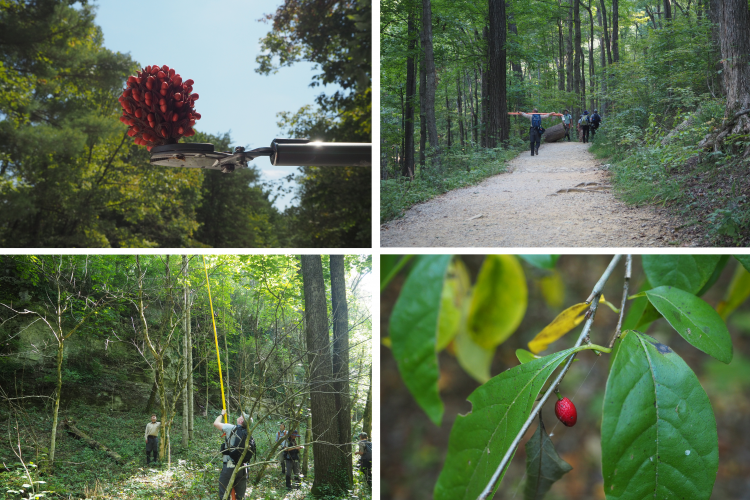Wild-Collecting Plants in Kentucky: Part 2
Wild-Collecting Plants in Kentucky: Part 2

This fall, The Arboretum embarked on two collecting trips to gather seeds and plants that will build the foundation for new plantings in the Walk Across Kentucky (WAKY). These wild-collected plants will help us preserve the heritage and genetic diversity of Kentucky’s flora.
The first of these collection trips arose from a unique opportunity to collect with a group from the North America-China Plant Exploration Consortium (NACPEC). This consortium of North American and Chinese botanical institutions has sponsored plant collection expeditions and the sharing of resources for over 30 years. This year, a group of experts from the Arnold Arboretum of Harvard University, as well as three Chinese colleagues from the Beijing Botanical Garden, the Kunming Institute of Botany, and the Chengdu Institute of Biology collected in natural areas throughout Appalachia, spending three days in Kentucky. UK Herbarium Curator Robert Paratley and I helped identify areas to collect and joined them during the Kentucky stretch of their trip.
The first day of collections was spent in the Daniel Boone National Forest and Red River Gorge Geological Area. After surveying several spots to collect, we finally found areas that had enough sun exposure to expect good seed set. Our first collection was a low-growing groundcover shrub, yellow-root (Xanthorhiza simplicissima), found along the banks of the Red River. This plant is in the Ranunculaceae or buttercup family, and is one of the few species in this family that has a woody stem. Other notable collections for the WAKY occurred when we found accessible populations of bigleaf magnolia (Magnolia macrophylla, pictured) and umbrella magnolia (Magnolia tripetala) growing in beautiful mixed mesophytic forests.
We spent our second day collecting in Berea College Forest. Also known as The Pinnacles, this site not only provided spectacular views, but also an interesting conglomeration of mixed mesophytic forests (pictured) and sandstone outcroppings. We collected a few species that don’t exist in the Knobs Region of the WAKY currently, including bladdernut (Staphylea trifolia), yellow buckeye (Aesculus flava), and our one herbaceous collection of the trip, swamp milkweed (Asclepias incarnata).
The third and final day of collections was at Floracliff Nature Sanctuary, located on the Kentucky River Palisades. It contains expertly preserved calcareous mixed mesophytic hardwood forests, limestone palisades, and streamsides. We collected seed from a vine that we did not have in our collection, leatherflower (Clematis viorna), that was precariously growing on the side of a limestone cliff. We also added a new accession of mockernut hickory (Carya tomentosa) to our collection.
Apart from this larger trip, the WAKY Native Plants Crew took a day trip to Bernheim Arboretum and Research Forest to collect seeds from trees and shrubs to add to the Knobs Region. We collected exclusively in the natural forest areas, visiting streamsides and upland oak-hickory forests. We collected a number of shrubs, such as spicebush (Lindera benzoin, pictured), wild hydrangea (Hydrangea arborescens), and devil’s walking stick (Aralia spinosa), and three species of oak. The only American beech (Fagus grandifolia) that we found with seed had been recently uprooted and was lying on the ground. This made seed much more accessible, and we have high hopes but somewhat low expectations for its viability.
In total, we collected seeds from 21 different species this fall; 13 trees, 6 shrubs, 1 vine, and 1 herbaceous perennial. These seeds have started their process of stratification and most will be sown in late winter. It will take several years to get some of these plants out on the grounds, and we still have plenty of plants on our desiderata, our desired species list. Some of these include the groundcover Allegheny spurge (Pachysandra procumbens), less common oaks like blackjack oak (Quercus marilandica), Rhododendron species and mountain laurel (Kalmia latifolia) from eastern Kentucky, and the beautiful and elusive yellowwood (Cladrastis kentuckea).
We are incredibly grateful to all the sites that gave us permission to collect, and especially to the NACPEC group for inviting us on the journey and being so generous with their time and resources.
